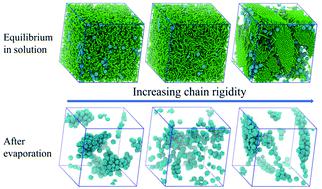Our official English website, www.x-mol.net, welcomes your feedback! (Note: you will need to create a separate account there.)
Nanoparticle assembly modulated by polymer chain conformation in composite materials.
Nanoscale ( IF 6.7 ) Pub Date : 2020-06-11 , DOI: 10.1039/d0nr01740j Shensheng Chen 1 , Emily Olson , Shan Jiang , Xin Yong
Nanoscale ( IF 6.7 ) Pub Date : 2020-06-11 , DOI: 10.1039/d0nr01740j Shensheng Chen 1 , Emily Olson , Shan Jiang , Xin Yong
Affiliation

|
Mixing nanoparticles into a strategically selected polymer matrix yields nanocomposites with well-controlled microstructures and unique properties and functions. The modulation of nanoparticle assembly by polymer chain conformation can play a dominant role in determining nanocomposite structures, yet such a physical mechanism remains largely unexplored. We hypothesize that highly ordered microdomains of rigid linear polymers provide a template for nanoparticle assembly into open fractal structures. We conducted mesoscopic computer simulations and physical experiments to elucidate how polymer chain conformation regulates the dynamic evolution of nanoparticle structures during the drying processing of polymer nanocomposite films. The evaporation of polymer–nanoparticle mixtures with varying chain stiffnesses was simulated using dissipative particle dynamics. The formation of distinguished nanoparticle assemblies as a result of matrix selection was further corroborated by probing nanoparticle aggregation in different polymer nanocomposite coatings. The results show that polymer conformation not only influences the dispersion states of individual particles (dispersed vs. aggregated), but also modulates the morphologies of large-scale assembly (globular vs. fractal). The emergence of nematically ordered polymer clusters when the chain rigidity is increased creates local solvent-rich “voids” that promote anisotropic particle aggregates, which then percolate into open fractal structures upon solvent evaporation. The nanoparticle dynamics also exhibits an intriguing non-monotonic behavior attributed to the transitions between the coupling and decoupling with polymer dynamics. The nanoparticle assembly morphologies obtained in simulations match well with the electron microscopy images taken in physical experiments.
中文翻译:

复合材料中聚合物链构象调节的纳米粒子组装。
将纳米颗粒混合到有策略地选择的聚合物基质中,可以得到具有良好控制的微观结构,独特性能和功能的纳米复合材料。聚合物链构象对纳米粒子组装的调节可以在确定纳米复合结构中起主要作用,但这种物理机制在很大程度上尚待探索。我们假设,刚性线性聚合物的高度有序的微区为纳米颗粒组装成开放的分形结构提供了模板。我们进行了介观的计算机模拟和物理实验,以阐明聚合物纳米复合膜干燥过程中聚合物链构象如何调节纳米颗粒结构的动态演变。使用耗散粒子动力学模拟了链刚度不同的聚合物-纳米粒子混合物的蒸发。通过探测不同聚合物纳米复合涂层中的纳米粒子聚集,进一步证实了由于基质选择而形成的独特纳米粒子集合体。结果表明,聚合物构象不仅影响单个颗粒的分散状态(分散与集合的对比),还可以调节大规模装配的形态(球状与分形)。当链的刚性增加时,向列型聚合物簇的出现会产生局部富溶剂的“空洞”,从而促进各向异性的颗粒聚集,然后在溶剂蒸发后渗入开放的分形结构。纳米粒子动力学还表现出有趣的非单调行为,这归因于与聚合物动力学的偶联和去偶联之间的过渡。在模拟中获得的纳米粒子组装形态与物理实验中获得的电子显微镜图像非常吻合。
更新日期:2020-07-16
中文翻译:

复合材料中聚合物链构象调节的纳米粒子组装。
将纳米颗粒混合到有策略地选择的聚合物基质中,可以得到具有良好控制的微观结构,独特性能和功能的纳米复合材料。聚合物链构象对纳米粒子组装的调节可以在确定纳米复合结构中起主要作用,但这种物理机制在很大程度上尚待探索。我们假设,刚性线性聚合物的高度有序的微区为纳米颗粒组装成开放的分形结构提供了模板。我们进行了介观的计算机模拟和物理实验,以阐明聚合物纳米复合膜干燥过程中聚合物链构象如何调节纳米颗粒结构的动态演变。使用耗散粒子动力学模拟了链刚度不同的聚合物-纳米粒子混合物的蒸发。通过探测不同聚合物纳米复合涂层中的纳米粒子聚集,进一步证实了由于基质选择而形成的独特纳米粒子集合体。结果表明,聚合物构象不仅影响单个颗粒的分散状态(分散与集合的对比),还可以调节大规模装配的形态(球状与分形)。当链的刚性增加时,向列型聚合物簇的出现会产生局部富溶剂的“空洞”,从而促进各向异性的颗粒聚集,然后在溶剂蒸发后渗入开放的分形结构。纳米粒子动力学还表现出有趣的非单调行为,这归因于与聚合物动力学的偶联和去偶联之间的过渡。在模拟中获得的纳米粒子组装形态与物理实验中获得的电子显微镜图像非常吻合。


























 京公网安备 11010802027423号
京公网安备 11010802027423号